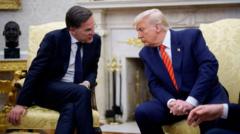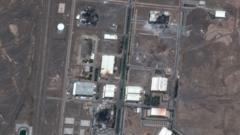On June 25, 2025, the United Kingdom confirmed its intention to purchase 12 F-35A fighter-bombers, marking a pivotal shift in its military posture by reintroducing a nuclear delivery capacity for its air force for the first time since the Cold War.
U.K. Strengthens Nuclear Capabilities with Purchase of 12 F-35A Jets

U.K. Strengthens Nuclear Capabilities with Purchase of 12 F-35A Jets
As NATO Summit unfolds, Britain announces significant military investment with F-35A stealth jets.
The announcement, strategically timed during the NATO summit taking place in The Hague, highlights Britain's enhanced nuclear role as it prepares to integrate modern capabilities into its defense strategy. The F-35A stealth jets will enable the Royal Air Force to carry both conventional and nuclear weapons, significantly bolstering its military power and flexibility in response to international threats.
Currently, Britain's nuclear arsenal relies on Trident submarines capable of launching cruise missiles, lacking the air-based delivery component that other NATO allies, such as France, already possess. The inclusion of F-35A aircraft aims to optimize operational readiness, particularly in crisis scenarios, amidst escalating concerns over the reliability of U.S. nuclear commitments to Europe.
Alongside this acquisition, the U.K. plans to join NATO's airborne nuclear mission, aligning its forces with allied aircraft configured to carry American B61 bombs stored throughout Europe. This progression is being hailed by Downing Street as "the biggest strengthening of the U.K.'s nuclear posture in a generation," and it signals a renewed focus on European defense in light of geopolitical tensions, including potential threats from Russia.
Previously, the U.K. operated F-35B jets designed for aircraft carriers; however, they were not capable of carrying out nuclear missions. With these developments, Britain re-establishes itself as a key player in NATO's multi-faceted defense strategy, increasingly integrated with allied nuclear capabilities on the continent.
As Britain positions itself to lead a stronger NATO front, this military investment illustrates a significant pivot towards an assertive defense posture in a rapidly evolving global landscape. The implications of these advancements will undoubtedly be a focal point of discussions during the ongoing NATO summit and beyond.
Currently, Britain's nuclear arsenal relies on Trident submarines capable of launching cruise missiles, lacking the air-based delivery component that other NATO allies, such as France, already possess. The inclusion of F-35A aircraft aims to optimize operational readiness, particularly in crisis scenarios, amidst escalating concerns over the reliability of U.S. nuclear commitments to Europe.
Alongside this acquisition, the U.K. plans to join NATO's airborne nuclear mission, aligning its forces with allied aircraft configured to carry American B61 bombs stored throughout Europe. This progression is being hailed by Downing Street as "the biggest strengthening of the U.K.'s nuclear posture in a generation," and it signals a renewed focus on European defense in light of geopolitical tensions, including potential threats from Russia.
Previously, the U.K. operated F-35B jets designed for aircraft carriers; however, they were not capable of carrying out nuclear missions. With these developments, Britain re-establishes itself as a key player in NATO's multi-faceted defense strategy, increasingly integrated with allied nuclear capabilities on the continent.
As Britain positions itself to lead a stronger NATO front, this military investment illustrates a significant pivot towards an assertive defense posture in a rapidly evolving global landscape. The implications of these advancements will undoubtedly be a focal point of discussions during the ongoing NATO summit and beyond.





















